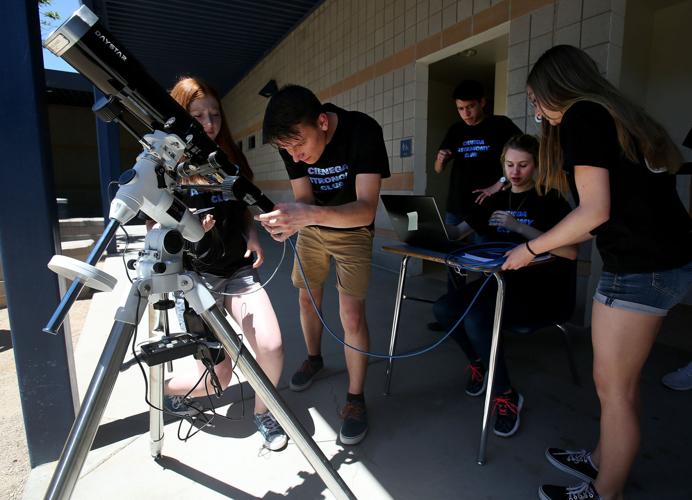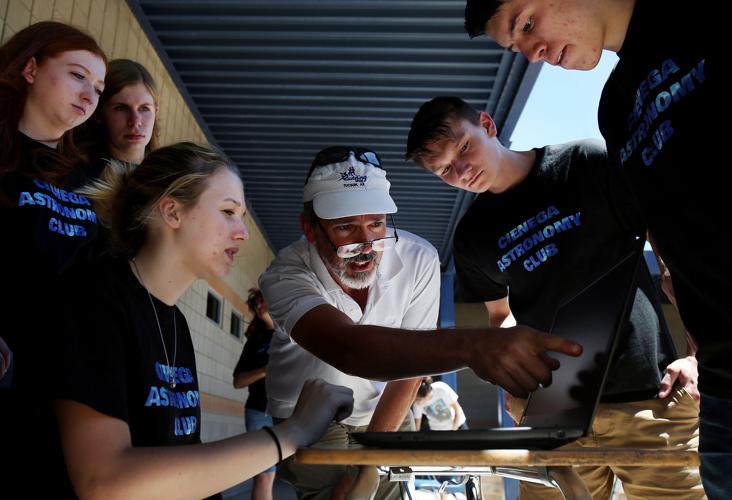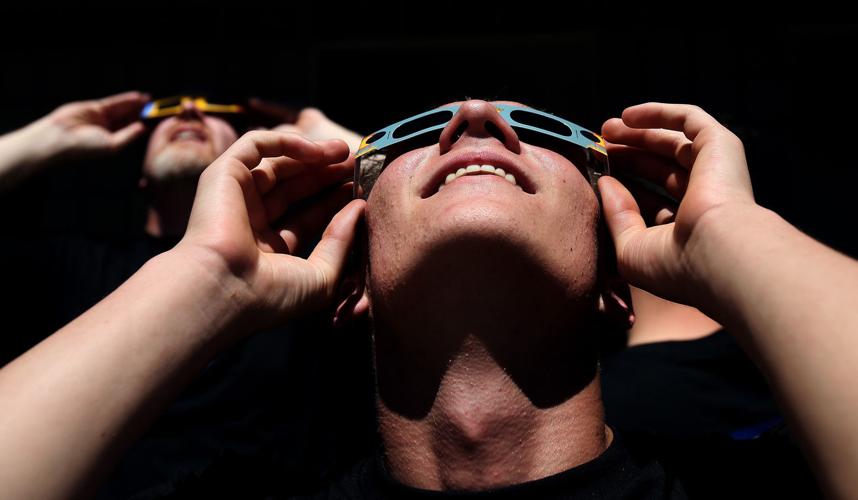If you can’t travel 1,000 miles north to view the total solar eclipse in August, the students in Jack Erickson’s astronomy club at Cienega High School have got you covered.
They are part of a 250-member team of citizen scientists who will deploy 60 identical telescopes along the continent-wide path of totality to produce a 90-minute movie that will detail the changing shapes of the sun’s corona.
If all goes well, a shortened clip will be available for viewing on the day of the eclipse, Aug. 21.
The longer version will be the subject of scientific inquiry by solar astronomers, who hope to confirm their theories about the halo of heated plasma surrounding the sun and maybe learn some new things. Any research papers written on the data will credit the entire team, including the students at Cienega.
The students gathered last weekend to train on their new telescopes and to learn the software program that will enable them to capture about two minutes of total eclipse data from the lawn of the public library in Pawnee City, Nebraska, a town of fewer than 900 people that is on the path of totality.
“I think it will be really exciting to be part of something this big,” said sophomore Bentley Bee, who took charge of the team’s computer during the morning tutorial as his classmates took notes on procedures being outlined by solar astronomer Matt Penn and Adriana Mitchell, a student in optical sciences and engineering at the University of Arizona.
Penn, of the National Solar Observatory, is coordinating the nationwide effort — supported by NASA and the National Science Foundation. He has enlisted 60 teams of students and professional and amateur astronomers in the Citizen Continental-America Telescopic Eclipse Experiment, known in brief as Citizen CATE.
At the workshop, he stressed the importance of capturing and preserving that data.
As Mitchell tutored the four teams from across the country about the software program, Penn offered encouragement, practical advice and warnings.
“Put the steadiest team member in charge of removing the solar filter,” he said, as he showed a movie of a similar experiment in Indonesia last year where the telescope was bumped off target during that process.
The filter protects the telescope’s CCD camera during siting and focusing. Like your eyes, the camera can only look at the sun without filters during totality.
Penn told the teams to simply rotate the telescope away from the sun at the end, rather than putting the filter back.
They have a more critical, immediate task: “Back up the data.”
“Use the USB stick. Practice. We need a copy in case you spill the champagne on your laptop.”
“Not at our site, buddy,” said Erickson, who, along with parent volunteer Michele McClellan, is taking the teenage club members to Lincoln, Nebraska, in August.
Erickson said he made reservations early in the closest big town — before he even knew exactly where the team would go. Hotel rooms and campgrounds are filling up along the path of the eclipse.
Eclipse viewing
Millions of Americans will be able to view the total eclipse by simply walking outside. It passes through mostly rural areas in the West and Midwest, but will be a short drive from many metropolitan centers, including the 3 million who live in and around St. Louis and 2 million in Nashville’s metropolitan area.
Cities and towns along the path of totality are expecting an onslaught of visitors and hosting a variety of events.
Tiny Madras, Oregon, population 6,533, is expecting 100,000 visitors, said Scott Dixon, one of five amateur astronomers from San Diego, who will be stationed there. “We have a reservation in a field,” he said. Fortunately, he also has an RV. Madras is hosting the Oregon Solarfest, promising sunny skies and a lineup of tribute bands on the eastern, dry side of Oregon’s rain-catching mountain ranges.
Carbondale, Illinois, which will see the longest totality (2 minutes and 20 seconds) is planning daylong festivities on the campus of Southern Illinois University.
NASA’s webcast, the EDGE, will be hosting four hours of “ESPN-style game day” programming in Carbondale, said Penn.
“Nova,” the PBS science program, will broadcast a same-day program that will include the shortened version of NSO’s eclipse movie.
That brief movie will also be posted on websites at NASA and the National Solar Observatory.
This is all weather-permitting, of course. With 60 sites, Penn said, he can lose a few without adversely affecting the science, but is hoping for clear skies everywhere.
Eclipse training
At Saturday’s training session, Penn responded to a question about clouds affecting the ability to take “flats” (images of sections of blank sky) for calibrating the camera image, by saying, “Just do the best you can and I don’t want to hear the C-word again.”
Operator error could also affect the results, but the students at Cienega seemed determined to keep that from happening in Pawnee City.
When the group moved outside for a test run, Bee and junior Daniel Stelly positioned the telescope as Julie VanVoorhis settled into the role of computer operator, smoothly running through the setup, calibration, focusing and collecting phases.
VanVoorhis said she was introduced to astronomy when she took Erickson’s freshman honors physics class. Then she was offered the opportunity to help capture the all-American eclipse.
“At first, I was really hesitant, but then I figured you can learn a lot of stuff by doing it,” she said.
Next year, she plans to take Erickson’s astronomy course and envisions a career that combines her love of business with her new-found interest in astronomy.
Stelly said he’s “more of an arts person” than a scientist, but said the astronomy class at Cienega was “his favorite science class by far” and that he has an interest in “anything to do with space.”
Savannah Shoffner said, “I never really thought about how science could be so interesting and that I could be a part of it.” She’s unsure what her future career will be but it will have “something to do with math and science.”
Sophomore Madison Kroeger said she signed on to the Citizen CATE experiment for the opportunity to create “new science. We’ll be looking at the corona, helping them confirm things they have suspected. I would just like to help Matt and his research team get the data.”
Corona study
Penn will be in Weezer, Idaho, a small town near the Oregon border, where he will collect data and then compile images from the 59 other sites to quickly make a 10-second movie showing changes in the corona as the shadow of totality sweeps across the continent from Oregon to South Carolina.
Changes will be more subtle in the longer movie, but should reveal information about the inner corona that is impossible to obtain, even from NASA’s space satellites, said Penn.
The best sun-blocking coronagraphs available for ground-based and space telescopes don’t block the sun’s light efficiently enough to image the corona closer than 2.5 solar radii from the surface, he said. “It’s a big black donut in most NASA movies.”
The sun is about 400 times larger than the moon, but it is also 400 times farther from Earth, a coincidence that makes it “the best occulting disk available,” he said.
The Citizen CATE experiment will explore that inner region of the corona. “Our main focus is the acceleration of particles above the poles of the sun,” said Penn. He describes the region as the “on-ramp” for the solar wind which has already reached speeds of 100 kilometers per second where scientists have been able to measure it. By the time those streams of charged particles reach Earth, they are traveling at 1,000 kilometers per second.
Penn said he is not “an eclipse chaser” but this will be his third total eclipse. As a graduate student, he collected data from the Hawaiian mountaintop of Mauna Kea in 1991, and went with a group to Chile’s Atacama Desert in 1994.
He told the students what to expect: The sky darkens, the temperature drops, birds stop chirping, night insects emerge, stars appear, the horizons color in a 360-degree sunrise/sunset. And, at totality, the corona appears around the blacked-out sun, in patterns that form along the sun’s magnetic field.
It is safe to look at the sun during totality, which will last between 30 and 150 seconds, depending on the site. It is not safe to look at the sun without special filters before or after totality, and not during the partial eclipse that will be visible over much of the nation, including Tucson, where about half the sun will be shadowed.
Look around instead, said Penn. Tree leaves and common objects, like car keys, cast amazing, crescent shadows.
Great opportunity
Penn said the eclipse is a great opportunity to interest people, especially students, in the work he does every day.
The Citizen CATE groups will be asked to plan future observing campaigns with their new telescopes, computers, cameras, mounts and drives, which they get to keep, courtesy of donations from Daystar Filters, Celestron and colorMaker. Mathworks donated programming.
In addition to the students mentioned in the article, the Cienega Astronomy Club team includes Brynn Brettell, Bruno Acevedo and Cole Bramhall. Jack Erickson’s daughter Ella and Michele McClellan’s daughter Emilie will also accompany the group.
Erickson said the Vail School District has been “fully supportive” of the effort, allowing the club to tap into the district’s state tax-credit donations for travel and lodging. The group also received a donation from Research Corp. for Science Advancement.






